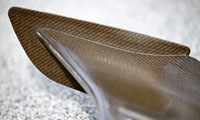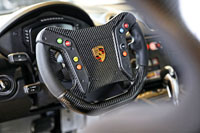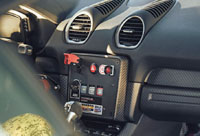
Decades ago Porsche was criticized for not making entry-level models that measured up to the much mightier 911, examples being the now 50-year-old ‘69-‘76 mid-engine 914 and ‘76–‘88 front-engine 924, but since the mid-engine Boxster convertible and Cayman coupe arrived on the scene, complainants haven’t been anywhere near as vocal.
Just the same, the brand’s new line of turbocharged flat-four powerplants that arrived in the current fourth-gen 718 series models have had their share of naysayers, yet while these engines’ barks aren’t quite as vicious sounding as the flat-six 911’s meatier growl, the 2.5-litre mill’s bite has kept most critics silent, particularly when tuned to GTS heights.
With respect to the 986, 987, 981 and today’s 982 platform architectures, the Cayman and Boxster were near perfect performers from the very beginning thanks to their relatively light curb weights and inherently well-balanced mid-engine layouts, and every generation became even better at managing high-speed road and racetrack performance.

As with the previous-gen Boxster and Cayman, the 718 series’ many more fans should also be happy to know that 2020 models are about to be built in their most formidable production trims yet, the upcoming 718 Spyder and 718 Cayman GT4 even capable of sprinting away from and outmaneuvering some 911 models.
To fill you in on some background information, the 718 Cayman (currently on sale from $63,700), can be had in base 300-horsepower Cayman trim that’s capable of zero to 100km/h in just 5.1 seconds, or 4.9 seconds when hooked up to its optional paddle shift-operated dual-clutch PDK automatic transmission, or a speedy 4.7 seconds with the PDK and the car’s available Sport Chrono Package, while if you keep its right pedal planted it can hit a top track speed of 275 km/h.
The entry-level coupe can also be upgraded to 350-horsepower Cayman S trim ($78,600), which can spirit away from standstill to 100km/h in only 4.6, 4.4 and 4.2 seconds respectively, plus it tops out at an even higher 285 km/h, while lastly the 365-horsepower Cayman GTS ($92,600) is capable of running from 0 to 100km/h in 4.6, 4.3 and 4.1 seconds respectively, while it claims a top speed of 290 km/h.

The just-noted 718 Cayman GT4 arrives at the top of this pecking order, just like the previous version did when introduced in 2015. Where the old Cayenne (and Boxster) had flat-six engines throughout its range, the new GT4 replaces the 718’s 2.0- and 2.5-litre turbocharged flat-four engines with a downgraded (but still amazing) version of the wonderfully high-revving naturally-aspirated 4.0-litre H-6 from the 911 GT3, producing a generous 414-horsepower and 309 lb-ft of torque, which is a 29-hp bump over the previous GT4 due in part to a sonorous 8,000-rpm redline, while it’s solely conjoined to a six-speed manual transmission just like the 911 GT3, all combining for a zero to 100km/h sprint time of 4.4 seconds, plus a terminal velocity of 304 km/h.
As for the 718 Spyder, which also updates a previous 2016 model, it shares all of the same mechanical bits as the Cayman GT4. This means it’s 39 hp more potent than the outgoing Spyder, resulting in the same 4.4-second 100-km/h sprint time as the Cayman GT4, although its top speed is fractionally lower at 301 km/h. Unlike the GT4, mind you, the open-top Spyder is quite different than the model using the Boxster nameplate, despite housed in its basic tub.

As noted earlier, the two new cars’ utilize a six-speed manual gearbox, which isn’t all that unusual in the class, but interestingly this transmission includes downshift rev-matching, or rather what Porsche refers to as an “Auto Blip” function, which automatically matches a given cog to engine speed when dropping a gear. Fortunately, Porsche makes this feature optional, in that a driver can individually activate or defeat it via a button. Also standard, both new models feature a totally new and exclusively designed sport exhaust system that works its way around the cars’ complex rear diffusers while making the most of the “exciting flat-six sound of the engine,” noted Porsche in its press release.
With respect to the two models’ outward designs, some key elements of the 718 Spyder appear like they were pulled from the 918 Spyder, not to mention the more recently introduced 911 Speedster. The 918 may have helped to inspire the 718 Spyder’s lower front fascia and similar, albeit much more pronounced, double-hump rear deck lid buttresses, while the new 911 Speedster may have influenced the 718 Spyder’s aggressive frontal treatment and double-bubble rear deck “streamliners”, as well as the new convertible’s vented hood, the “Spyder” lettering on its shortened B-pillars (which read “Speedster” on the 911), the similarly sculpted automatically-deploying rear spoiler, and the working rear diffuser.
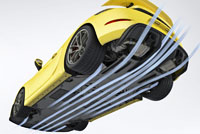
The new 718 Cayman GT4, on the other hand, pulls forward a number of similar styling cues and aero details from its 2016 predecessor, including the aggressively shaped front fascia, the horizontal black strip of hood venting, the large fixed rear wing, the wind-cheating rear diffuser, and the uniquely designed alloys, all developed with a focus on minimizing weight and maximizing downforce. The fact Porsche even painted both GT4 launch cars in a seemingly identical yellow hue is no coincidence either, just like they once again coated the latest 718 Spyder launch model in white.
With an eye looking back to aerodynamics, each and every 718 Cayman GT4 exterior upgrade combines for 50 percent greater downforce with no negative affects on drag. Most of the aero advantages can be attributed to the new diffuser and rear wing elements, the latter feature good for 20-percent greater aero-efficiency than the outgoing GT4 wing. At the other end of the car, a deep lip spoiler joins up with air curtains to each side, this helping to channel air around the front wheels.

Now with our focus on the 718 Spyder’s aero upgrades, its adaptive rear wing automatically powers upwards at 120 km/h, but unlike the conventional 718 Boxster’s retractable fabric roof, the Spyder’s top doesn’t benefit from electrical assistance, but instead requires manual removal and stowage below the rear deck cover. When replaced on top of the passenger compartment, Porsche promises a roof that can manage the Spyder’s high top speed without issue, providing full protection from wind, rain and more.
Behind the scenes, both new models integrate a lightweight, high-performance chassis design that’s capable of keeping the engine and aero capabilities in check. Porsche leaned on its extensive motorsport heritage in order to achieve an ideal balance for the new Spyder and GT4, choosing to equip both with a model-exclusive rear axle, and a front axle adopted from the 2018 911 GT3.

Additional standard features include Porsche Active Suspension Management (PASM), providing a 30-millimetre ride-height reduction when compared to regular 718 models, this lowering the new models’ centre of gravity, thus improving overall handling. Still, owners have the ability to manually adjust the suspensions’ camber, toe, ride-height and anti-roll bar settings, important for those who regularly hone their skills on the track.
The now legendary 911 GT3 also provided the two new models’ braking setup, including their larger 380-mm cast iron rotors and fixed aluminum calipers, while buyers of either car can choose to upgrade to a set of ceramic composite brakes if desired, these 50-percent lighter and featuring discs that measure 410 mm up front and 390 mm in the rear. Additionally, the 718 Spyder and Cayman GT4 feature specially tuned ABS, electronic stability control (ESC) and traction control (TC) systems that enhance the cars’ performance, with these ESC and TC systems capable of being switched off via a two-stage process.
Yet more upgrades include a standard mechanical limited-slip differential with Porsche Torque Vectoring (PTV), plus unique 20-inch alloy rims shod with 245/35ZR20 front and 295/30ZR20 rear UHP rubber.
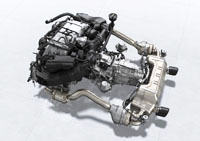
As you may have noticed, the many performance upgrades mentioned up to this point don’t necessarily make the new 718 Spyder or 718 Cayman GT4 quicker off the line than GTS versions of either model, but both are faster on the track, and therefore should be better for everyday driving, at least when pushing the limits. With respect to racetrack limits, Porsche claims its new 718 Cayman GT4 is capable of lapping the Nürburgring Nordschleife “more than ten seconds faster than its predecessor.”
Making the two new models more enjoyable to live with are upgraded interiors that include a special 360-mm GT Sport steering wheel with a cool yellow top-centre “marker” in Cayman GT4 trim. Additionally, both 718 Spyder and Cayman GT4 receive a 20-mm shorter shift lever that provides a “more direct and crisp feel” when changing gears. What’s more, a new Sport Seats Plus package comes standard, boasting seats with larger side bolsters to enhance lateral support, plus suede-like Alcantara inserts to improve backside grip. Alcantara also gets applied to a lower portion of the instrument panel, as well as the shift knob and boot, and the previously mentioned steering wheel rim.
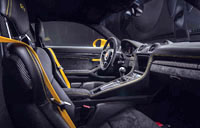
On top of this, some cabin accents include body-colour trim for the 718 Spyder, and brushed aluminum details for the 718 Cayman GT4, while Porsche offers plenty of available décor upgrades as well. What’s more, you can opt for a set of full bucket seats or an 18-way power-adjustable Adaptive Sport Seats Plus package, but take note you won’t be required to pay more for air conditioning or the brand’s newest Porsche Communication Management (PCM) system that also features Sound Package Plus. This said, a navigation system and Porsche Connect, featuring Apple CarPlay, are optional.
Also noteworthy, the 718 Spyder can be ordered with a Spyder Classic Interior Package that includes two-tone Bordeaux Red and Black leather upholstery, extended Alcantara, GT silver metallic interior trim, and a two-tone black and red fabric top, the latter “reminiscent of historic Porsche racing cars” says Porsche. Alternatively, red, silver, or yellow contrast stitching is available.
However you’d like to order yours, I wouldn’t recommend waiting too long as Canada’s allotment will soon be spoken for. They’re currently available to order, with pricing beginning at $110,500 for the 718 Spyder, and $113,800 for the 718 Cayman GT4, plus a freight charge and other fees of course.
While you’re waiting for your new 2020 718 Spyder or 718 Cayman GT4 to arrive, make sure to check out all the videos Porsche provided below:
The new Porsche 718 Spyder. Perfectly irrational. (1:03):
The new Porsche 718 Spyder. Product highlights. (2:25):
The new Porsche 718 Cayman GT4. Product highlights. (2:13):
The new Porsche 718 GT4. Perfectly irrational. (1:01):
Story credits: Trevor Hofmann
Photo credits: Porsche




